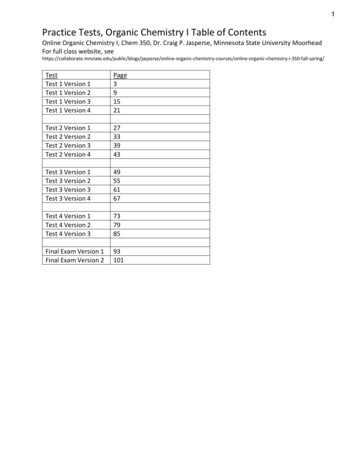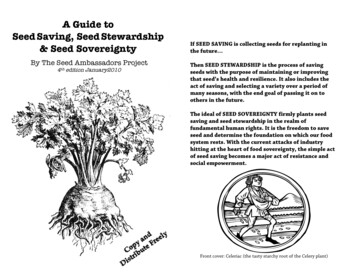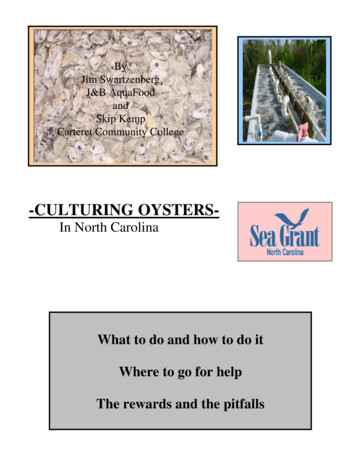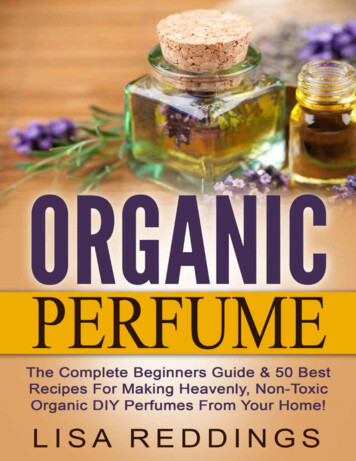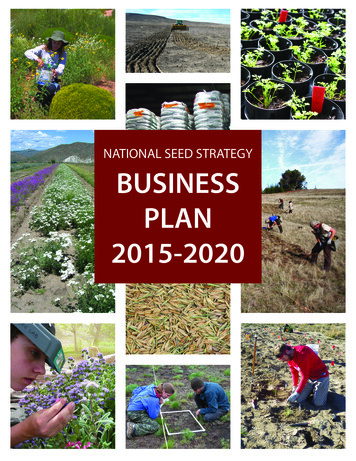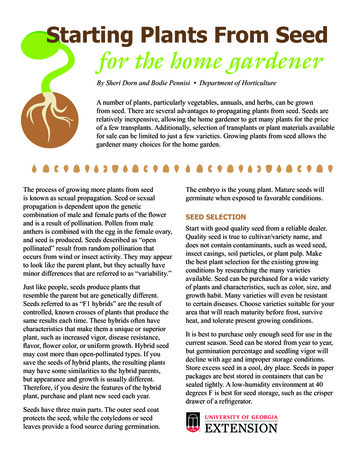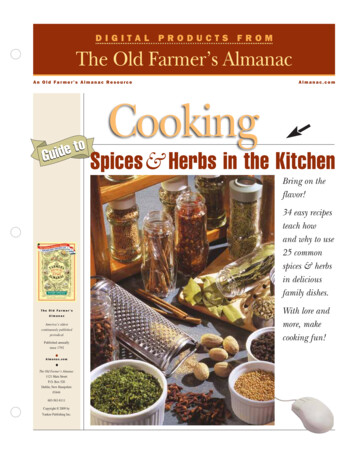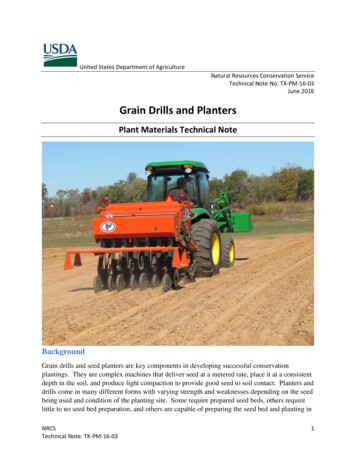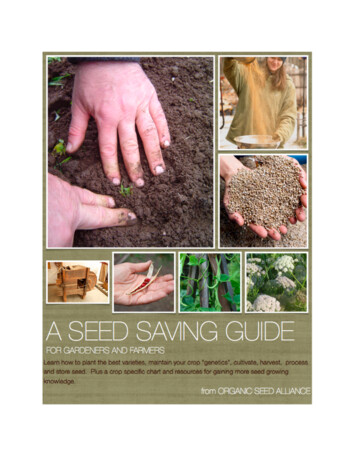
Transcription
Table of ContentsINTRODUCTION . 3OPEN POLLINATED VARIETIES & HYBRIDS: Know how to choose a variety that produces offspring like its parents. 4ANNUALS & BIENNIALS: Know how long it will take for your crop to produce seed . 4BOTANY VOCABULARY: Know some basic botanical terms. 5INBREEDING AND OUTBREEDING: Know your crop’s mating system. 5POLLINATION AND FERTILIZATION: Know how to promote a good seed set . 6ISOLATION, POPULATION SIZE AND ROGUING: Know how to maintain your crop’s genetics. 7Isolation methods. 7Population size . 8Roguing . 9SOIL AND CULTIVATION: Know the in-field needs of your seed crop . 9Soil preparation. 9Spacing. 9Staking and Trellising . 9Managing disease . 10Managing weeds. 11HARVEST AND PROCESSING: Know about wet seeded and dry seeded crop methods of harvesting and processing . 11Dry Seeded Crops. 11Wet Seeded Crops . 14SEED STORAGE: Know how to protect your seed and keep it viable. 16GERMINATION: Know your seed’s germination rate . 18SPECIFIC CROPS: Seed saving tips for common vegetable crops. . 19CROP SPECIFIC CHART: . 25RESOURCES . 28Books. 28Web .28Sources of seed cleaning equipment . 29Seed Saving Organizations . 29
Introduction to the GuideOrganic Seed Alliance supports the ethical development and stewardship of the genetic resources of agricultural seed.Teaching farmers and home gardeners to produce and save their own seed is an important component of that work. We teachseed saving skills in workshops around the country, and through publications such as this. In doing so, we aim to helppreserve crop biodiversity, diversify farm income, and increase farmers and gardeners involvement and investment inregional seed systems.This guide outlines most of the things you need to know to grow seed successfully. It covers the basics of seed growing fromchoosing appropriate varieties for seed saving to harvesting, processing, and storing seed. It assumes that you have basicknowledge of vegetable growing.The information contained in this guide was gleaned from numerous print and web resources, as well as from conversationswith many prominent seed experts. We have endeavored to provide you with the best and most reliable information, but thisguide is in no way a rigid formula for seed growing perfection. As you gain seed growing experience, you will find that yourown personal knowledge of “reality on the ground” is just as important as recommendations from experts. Only throughexperimentation can you learn which practices work best in your climate and farming system.This publication was made possible through generous contributions to Organic Seed Alliance from private donors whosupport regional seed systems by preserving the art, history and science of seed saving.So, without further ado, we welcome you to the wonderful world of seeds. May this guide help you on your way to manyseasons of delight and discovery in your gardens and fields.The research and education staff at Organic Seed AllianceApril 2010Organic Seed Alliance PO Box 772, Port Townsend, WA, 98368 360.385.7192For PDF versions of this and other seed publications, please visit us at www.seedalliance.org
Open Pollinated Varieties and HybridVarieties: Know how to choose a variety thatThird, the plant must survive the winter. Successfuloverwintering mainly depends on cool (but not too cold)temperatures. In areas where winter temperatures do notregularly drop below 14F (-10C), most biennial crops mayremain in the field over the winter. In this case, it is especiallyimportant that the plants be small (i.e. hardy) enough towithstand cold temperatures. Where temperatures do regularlydrop below 14F (-10C) the crop must be lifted and stored in acool (but not freezing) location. Digging up the crop forstorage offers an opportunity to discard any plants that showundesirable characteristics in root shape, flavor, size andtexture, and to check for insect or disease infestations. Storingyour crop over the winter may also provide better protectionfrom pests and disease. Replant your stored roots in the spring.produces offspring like its parents.Open pollinated (OP) varieties produce offspring that closelyresemble the parent. For example, if a gardener grows the OPbean variety ‘Kentucky Wonder’ and saves seed, she will findthat when she grows out her seed next season, her ‘KentuckyWonder’ beans will look very much like what she grew lastyear. OP varieties result from the combination of parents thatare genetically similar and share specific traits that distinguishthe variety.Hybrid varieties result from the controlled crossing ofgenetically distinct parents. They produce offspring verydifferent than their parents. For example, if a gardener growsthe hybrid tomato variety ‘Early Girl’ and saves seed, she willfind that when she grows this seed next season, there will bevery few plants that closely resemble ‘Early Girl.’ In general,unless you are interested in a long term breeding project, avoidsaving seeds of hybrids.Storing biennial crops over winterBiennial plants are commonly trimmed in some manner priorto storing over winter. Trimming is done to reduce the rate oftranspiration and reduce the amount of vegetative materialsubject to rotting. For biennial root crops (also calledstecklings) the tops are commonly trimmed to !-1in. Onceprepared for storage your biennial should ideally be stored atbetween 35-38F (1.5-3C) and at 90-95% relative humidity.For this, you can use an electric cooler with a humiditycontrol. In the cooler, place wooden totes packed with clean,sound stecklings. The totes should have slotted planks thatallow air and humidity to flow freely around the roots. Underhigh humidity conditions, standing water can accumulate onthe surface of the uppermost layer of roots. Covering the toteswith a two to three inch layer of clean wood shavings (notsawdust!) will help absorb this extra moisture and reduce rotproblems. We recommend cedar wood shavings, if available,as cedar is reported to have a higher level of anti-microbialfactors than most other types of wood.Annuals and Biennials:Know how long it takes for your crop toproduce seed, and how to manage crops thattake two growing seasons to set seed.An annual crop requires only one growing season to produceseed and complete its lifecycle. Examples of annual seed cropsinclude corn, beans, squash, tomatoes, and broccoli.A biennial crop requires 2 growing seasons to produce seedand complete its lifecycle. Examples of biennial crops includecarrots, beets, chard, rutabaga, and cabbage. In the firstseason, a biennial grows into the plant that we normally eat. Ifthe following three criteria are met, a biennial will flower andset seed in the second season.You can also store stecklings in traditional root cellars, whichbenefit from cold temperatures and high humidity. In rootcellars, carrot stecklings are traditionally stored in moist, cleansand or clean, undecayed deciduous leaves (in New Englandgrowers sometimes use maple leaves). The roots are laidcarefully between layers of this material so as not to toucheach other.First, over winter, the plant must go through an importantperiod of vernalization (exposure to cold) before it willflower. The specific amount of time that biennial crops need tobecome vernalized varies by crop and variety. But exposure totemperatures below 50F (10C) for at least 8 to 12 weeks isadequate for all common biennial vegetable crops.Days to harvestWhether a crop is an annual or a biennial, it is also importantto consider how many days of warm weather it needs before itwill produce harvestable seed. Some crops like cilantro canrequire only 100 days to produce seed. Other crops like drybeans can require 4-5 months or more to complete maturity. Ifyou live in a region with a cool and/or short growing season,you will need to experiment to see which crops can producegood yields of seed in your climate. Starting plants early in agreenhouse will help give your crops a head start.Second, by the fall of the first season, the plant must beappropriately sized. Plants that are too small in the fall maynot reach full size before flowering, resulting in lower seedyields. In other cases, very small plants may not respond tovernalization; never flowering and setting seed. Plants that aretoo large may not be hardy enough to survive in the field overthe winter. For crop specific information on appropriate sizingof some biennials and other overwintering tips, see CropSpecific Seed Saving Tips in this guide.Organic Seed Alliance · www.seedalliance.org4
Botany Vocabulary:Pistil. The pistil is the female reproductive structure of aflower. It is made up of; 1) the stigma which receives pollen,2) the style, which connects the stigma to the ovary, 3) theovary, which matures into a fruit, and contains 4) ovules thatfuse with sperm to become seeds.Know some basic botanical termsInbreeding and Outbreeding:Know your crop!s mating system.The way that a plant mates can be described as falling along aspectrum between “strongly inbreeding” and “stronglyoutbreeding.” One end of the spectrum begins with plantspecies with bisexual flowers that remain closed, thereforelargely self-pollinating and strongly inbreeding. Then there arecrops with bisexual flowers that remain closed, though not astightly as the former category, and have a significant rate ofoutbreeding. Moving to the outbreeding plant types are themany crop species that have bisexual flowers that open atsexual maturity allowing high levels of outbreeding from windand pollinating insects, but that will inbreed when selfpollinated. Some of these crops with open bisexual flowerswill inbreed at a lower rate as the male and female sexual partswill mature at different times. Monoecious crops are evenmore likely to cross as the staminate and the pistilateunisexual flowers are physically separated, although they stillcan inbreed when self-pollinated. A notable minority of cropspecies have mechanisms that prevent inbreeding and enforceoutbreeding. Some crops have self-incompatibility, abiochemical system that won’t allow them to accept their ownpollen, thereby preventing inbreeding under mostcircumstances. The most powerful system for outbreeding isdioecy, where dioecious plants only have unisexual flowers ofone sex or the other on individual plants. A plant’s place onthis spectrum has several implications for its management as aseed crop.Bisexual flower: A flower that contains both types ofreproductive organs, i.e. both the stamen and the pistil. Alsocalled a “perfect” flower.Unisexual flower: A flower that contains only one type ofreproductive organ, i.e. either the stamen or the pistil. Alsocalled an “imperfect” flower.Monoecious: In monoecious ,crops each plant will house bothkinds of reproductive structures separately in differentunisexual flowers, i.e. separate male and female flowers on thesame plant Monoecious means “one house” in Latin.Examples include corn, cucumbers and squash.Dioecious: In dioecious crops half of the plants will houseonly staminate flowers (stamens only), while the other halfwill house only pistilate flowers (pistils only). Dioecious cropsonly have imperfect flowers. Dioecious means “two houses”in Latin. Examples include asparagus, spinach and date palms.Inbreeding. In plants, inbreeding (also called self-fertilizationor selfing) occurs when the sperm of an individual plantfertilizes an ovule of the same plant. Essentially, the plantmates with itself. An inbreeding plant’s offspring receive allof their genes from that one parent, thus the progeny is verysimilar to its parent.Pollination: Pollination is the process by which pollen istransferred from staminate to pistilate flowers in plants,thereby enabling subsequent fertilization and reproduction.Pollen tube: The pollen tube forms from a germinating pollengrain on the stigma and acts as a conduit to transport spermcells to the ovules.Two important advantages of inbreeding include:a) In plants that have evolved to become extremely welladapted to their environment, inbreeding offers a way toensure that a plant’s offspring will be just as well adapted asits parents. In other words, it is a way of replicating success.b) Inbreeding helps to ensure reproduction in varyingcircumstances, as it does not require the presence of wind,insects, or animals to transfer pollen from one plant to another.Strong Inbreeders. The plants that we call “strong inbreeders”rely almost completely on self-fertilization to reproduce. TheFertilization: Fertilization is the process by which sperm cellstravel through the pollen tube to the ovary. Fertilization iscomplete when the sperm fuses with an ovule, eventuallyleading to the formation of a seedStamen. The stamen is the male reproductive structure of aflower. It is made up of; 1) the anther, which produces pollen,which contains the plant’s sperm, 2) the filament whichsupports the anther.Organic Seed Alliance · www.seedalliance.org5
flowers of these plants have ways of excluding pollen fromother flowers of the same species. For example, in the flowersof most modern tomato varieties, the anthers form a conearound the pistil, effectively sealing off the flower’s stigmafrom any pollen besides its own. In peas, the petals of theflower are typically closed during the period of time that thestigma is receptive to pollen, giving pollen from its ownanthers exclusive access for pollination. When the pea floweropens, it is already fertilized. Other examples of stronglyinbreeding plants include lettuce, common beans, and wheat.other plants of the same species decreases. For example, if acorn plant is isolated from other corn plants, all of its offspringwill be inbred.The Plants In-BetweenBetween the “strong inbreeder” side of the mating spectrumand the “strong outbreeder” side of the mating spectrum areplants that will self-fertilize some of the time and crossfertilize some of the time. For example, in an average field offava beans, it is likely that about 50-75% of the flowers will beself-fertilized and 25-50% of the flowers will be crossfertilized, thanks mainly to bees.Even a strong inbreeder, however, will occasionally cross withanother plant of the same species. For example, bees can eatthrough or tear open a strong inbreeder’s flower petals anddeposit pollen from a different plant. Also, under certainclimatic conditions, an inbreeder’s flower will open while it isreceptive and the stigma will receive pollen from another plantbefore it has been self-pollinated by its own anthers. And, ofcourse, a human with the intention of creating a new cross cantransfer pollen from one strongly inbreeding plant to another.Classifications in the Crop Specific ChartIn the Crop Specific Chart of this guide we have classifiedmany major crops into the following five categories: Stronglyinbreeding; Generally inbreeding; Both inbreeding breeding. In reality, the place of many plant species in oneof these categories is mutable, as many species’ level ofselfing or outcrossing varies greatly depending onenvironmental conditions. Nevertheless, these classificationsare a good way to help you get familiar with the tendencies ofyour seed crop.Outbreeding. In plants, outbreeding occurs when the sperm ofone plant fertilizes an ovule of a different plant of the samespecies (also called cross-pollination or outcrossing). In otherwords, a plant mates with another plant of the same species.When plants outbreed, they produce offspring that aregenetically different than both parents. In general, all plantshave the potential to outbreed, because every plant can befertilized by another plant of the same species.Pollination and Fertilization:Know how to promote a good seed setIf your crops are not adequately pollinated and fertilized, theywill not produce viable seed. Your plants must overcome twohurdles for fertilization to occur: First, pollen must land on thestigma (pollination), second, the plant’s sperm must travel toand fuse with the ovule (fertilization).The central advantage of outbreeding is that it facilitates aplant species’ ability to adapt to changing environments. Plantspecies that constantly mix their genes into new combinationsincrease the likelihood that a few individuals within theprogeny in any generation will have a certain combination ofgenes to withstand any new environmental challenges.Pollination needs for strong inbreeders: While the journey ofthe pollen of a strong inbreeder is undoubtedly short (usuallyfrom an anther to a stigma within the same flower) goodpollen coverage of the stigma often requires some externalmovement. The movement caused by wind, and in some casesinsect visitation (even when the insect is unable to open theflower) can substantially increase pollination and promote agood seed set.Strong Outbreeders. The plants that we call “strongoutbreeders” rely completely or almost completely on crossfertilization to reproduce. Dioecious plants and plants that areself-incompatible have eliminated any chance of selffertilization; they exclusively outbreed. Strong outbreedersthat are not dioecious have ways of discouraging (but notcompletely eliminating) self-fertilization. For example, incorn, which is monoecious and has the male and femaleflowers situated on different parts of the plant, the maleflowers (the tassle) mature and release the majority of theirpollen before the female flowers (the cobb) open. Thesestrategies help to ensure that little self-fertilization occurs incorn. Other examples of strong outbreeders include beets,broccoli, and spinach.Make sure you address the need for external movement ofyour strongly inbreeding crop. If your crop is being grown in alocation with no wind and few insects (such as a greenhouse),you may need to use a fan or manually shake the plants. Youmay also need to encourage a diversity of insects in yourgarden or farm so that more of them will jostle your crop’sflowers.Pollination needs for plants that depend to some degree onoutbreeding: The more a crop relies on outbreeding forreproduction, the more important are the following threeelements in ensuring a good seed set: 1) a sufficiently largeAs stated above, strong outbreeders that are not dioecious orself-incompatible will self-fertilize. The likelihood of selffertilization increases as the opportunity to receive pollen fromOrganic Seed Alliance · www.seedalliance.org6
population of the crop flowering in unison, 2) adequate insectpopulations visiting the crop or adequate wind/airflow, and 3)environmental conditions that allow pollen to remain viablefrom the time it leaves an anther until it reaches a stigma (if itis too hot or too dry, pollen may lose viability before reachinga receptive stigma).therefore of the same species. The scientific name of a speciesis formed by the combination of two terms: the first term is theplant’s genus, the second is its specific epithet. These twonames are usually Latin in origin and used together designatethe species binomial name that is recognized by botanistsworldwide.Study the specific pollination needs for your outbreeding cropand make sure to address all three requirements for goodpollination. Depending on your situation, you may need togrow more plants than originally planned, encourage adiversity of pollinating insects, discontinue overhead wateringduring flowering (insects don’t fly well when the sprinklersare on), use a fan to introduce wind if growing seed in anenclosed structure, change your planting date to assure betterenvironmental conditions during flowering, and in some casespollinate by hand. You may find that your climate is notconducive for pollination of a certain crop. If so, you will needto choose a different crop from which to save seed.Plants that share your crop’s binomial name (both its genusand specific epithet) are the same species as your crop. Forexample, cabbage, European kale, broccoli, Brussels sprouts,and cauliflower are all the same species--- they share thescientific name Brassica oleracea. Therefore, if you wanted togrow cabbage seed, you would need to isolate it fromEuropean kale, broccoli, Brussels sprouts, and cauliflower.Domesticated carrot and wild carrot (commonly known asQueen Anne’s Lace) are both Daucus carota, hence carrotseed crops must be isolated from Queen Anne’s Lace. Thebinomial scientific name of most common vegetable cropspecies can be found in the Crop Specific Chart in this guide.Fertilization needs for all crops: Regardless of matingsystem, once pollen has reached the stigma, requirements forfertilization are the same for all crops: Environmentalconditions must be right for the pollen to germinate and growa pollen tube, and for the sperm to remain viable as it makesits journey to the ovule. If it is too hot or too cold the pollentube may stop growing and the sperm will not reach the ovule.For instance, a heat loving crop like tomatoes may producefewer fruit and low seed yields when it is exposed to coldnight time temperatures during flowering. This can be becauseit was too cold for pollen tubes delivering sperm cells of thetomato to complete their journey from stigma to ovule. Ingeneral, the climatic needs of your crop for fertilization aresimilar to the climatic needs of your crop for normal vegetableproduction. If your climate is not conducive to the fertilizationof a crop, you may need to reconsider it as a seed crop.Look for potentially contaminating plants among these threegroups; 1) wild plants in your area that are the same species,2) other varieties of the same species that you may begrowing, and 3) other varieties of the same species that othersin your area may be growing.Isolation MethodsIsolating with timeTo isolate two varieties of the same species by time, plant onevariety earlier than the other. The first variety must be plantedearly enough that it has completed its pollination period andset seed before the second variety begins to flower. Someexamples of crops that can easily be isolated using timinginclude corn, sunflowers, and basil, but you must be observantto make sure that they are not flowering at the same time.Isolation, Population Size and Roguing:Isolating with physical barriersYou can isolate your crops using physical barriers such aspaper or cloth bags, cages of very fine mesh, rows of thicklyplanted flowers, shrubs or trees, buildings, etc. Physicalbarriers such as thick vegetation, hills or buildings can at leastpartially block foreign pollen-bearing wind and insects. Bagsand cages can virtually eliminate any contamination fromforeign pollen, but they have two drawbacks: First, they oftenrequire involved pollination techniques. For example, seedgrowers who use cages to isolate carrots must release flylarvae inside the cages to allow for pollination. Second, usingbags and cages makes maintaining an adequately sizedpopulation more difficult, as these strategies require a largerper-plant investment of time and materials. For moreinformation on using bags and constructing and using isolationcages see Seed to Seed by Suzanne Ashworth.Know how to maintain your crop!s geneticsIsolation from contaminating pollenIsolation involves protecting your seed crop from the pollen ofplants of the same species that you did not intend it to crosswith. In other words, isolation keeps contamination of yourcrop’s genetics to a minimum. First we will discuss how youcan identify the plants that will cross with your crop, then wewill discuss the isolation methods you can use to protect yourcrop from receiving pollen from those plants.Plants that can cross-pollinate with your seed cropTo know which plants’ pollen might potentially contaminateyour crop, you must learn the scientific name of your crop andfind out which plants share that scientific name and areOrganic Seed Alliance · www.seedalliance.org7
Isolating with distanceYou can use distance to isolate your crops by planting themsufficiently far away from sources of contaminating pollen.The distance required for effective isolation varies fromspecies to species. A general guideline, however, is that plantsthat mostly inbreed require less isolation, while plants thatmostly outbreed require more isolation. For plants that tend tooutbreed, those that are primarily insect-pollinated require lessisolation than those that are primarily wind-pollinated. Idealisolation distances are not absolute and cross-pollination canoccur even when observing recommended isolation distances!Isolation requirements can vary with environmental conditionsand expert recommendations for the same crop vary widely.In the event of accidental crosses, you may be able to workyour way back to a pure variety by removing off-type plants infollowing generations. The number of generations required toremove an unwanted cross will depend on the degree ofcrossing and whether your crop is predominantly a self-orcross-pollinated species. Ultimately, isolation distances are arisk management tool and only you can assess what level ofrisk is acceptable for the seed you are saving.Population SizeWhy population size mattersMaintaining an adequately sized population entails savingseed from enough plants to retain your variety’s geneticvariability. Genetic variability refers to genetic differencesamong plants in the same variety. For instance, one plant ofthe Red Russian Kale variety may differ from another of thesame variety in flavor, vigor, resistance to insects and disease,tolerance to drought, or other important traits. There are tworeasons that maintaining genetic variability is important:We have provided two sets of recommendations on isolationdistances for most commonly grown vegetable species in theCrop Specific Chart in this guide. Our recommendations forhome use are based on the assumption that your seed savinggoal is to maintain a pure variety and to manage your cropwith a fair degree of assurance that you won’t have crossingwith a nearby variety of the same species. For species thattend to outbreed, we have recommended distances for homeuse that are adequate to avoid most cross-pollination, but arenot prohibitive and allow one to scout and manage potentialsources of contaminating pollen within the recommendedradius. For species that tend to inbreed, we have recommendeddistances for home use that are adequate both to avoid m
For PDF versions of this and other seed publications, please visit us at www.seedalliance.org . the hybrid tomato variety ‘Early Girl’ and saves seed, she will find that when she grows this seed next season, there will be . called a


